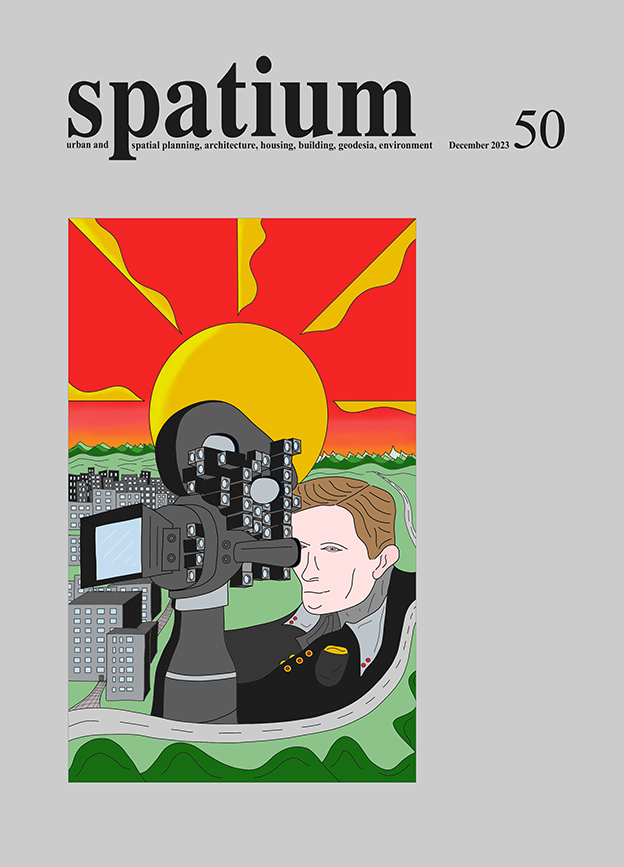Analysis of architectural urban spaces based on space syntax and scenario methods
DOI:
https://doi.org/10.2298/SPAT230407010OKeywords:
theory of architecture, design paradigms, architectural environment, perception, plot, public spaces, configurational models, spatial analysis, sustainabilityAbstract
The article aims to examine the scenario design process, with the goal of creating an architectural environment with a better perception of urban spaces. Space analysis and generalization of the plot structure of films, as well as their types and genres, which correlate with the plot composition of the urban architectural space and spatial syntax, were used as an approach in the study. This made it possible to investigate the relationships between spatial planning and a number of social, economic and environmental phenomena. As a result of studying the plot composition of a film, it was established that its structural elements and the features of those elements can be used to analyze the architectural environment, in order to study its plot structure based on configurational models of space. Thus, the legitimacy of using cinematographic analysis for the analysis of the architectural environment was confirmed. The plot structure of the architectural environment of the city is understood as its urban structure, which, like in cinematography, can develop linearly, i.e., from the beginning of the route to the end point along one line of a street, or be more complex (non-linear), whereby all elements are placed in an arbitrary order. In cinematography, the idea of the film organizes the plot and sets the formula for the finale; however, in the architectural environment, a person, moving in the city, perceives this environment through the spatial and temporal aspect that has developed historically. Hence, the architectural and artistic appearance of the city is of crucial importance.
References
Council of Europe (1986). Recommendation Council of Europe No R(86)11 “Of the Committee of Ministers to Member States on Urban Open Space”. Brussels: Council of Europe [online]. https://rm.coe.int/09000016805101ab [Accessed: 18 May 2023].
Domin, N. M. (2012). Gorodskie aglomeratsii v kontekste issledovaniya fenomena form i sistem rasseleniya (in Russian), Urban Development and Spatial Planning, Vol. 45, No.1, pp. 3-15. http://repositary.knuba.edu.ua//handle/987654321/10364
Field, S. (2007). Script – the basics of screenwriting. New York: Random House Publishing Group.
Hillier, B. (2007). Space is the machine. A configurational theory of architecture. London: Space Syntax.
Hillier, B., Tzortzi, K. (2006). Space syntax: The language of museum space. In: Sh. MacDonald (Ed.), A Companion to Museum Studies, London: Space Syntax, pp. 282-298. https://doi.org/10.1002/9780470996836.ch17
Kopteva, G. L. (2009). The semantics of the “threshold” in the architectural rhythm of the urban environment. Kharkiv: National University of Urban Economy named after O. M. Beketov.
Korshunov, V. (2015). Types of non-linear scenario composition. Odesa Film Studio [online]. https://www.odesafilmstudio.com.ua/uk/news/archive/vidy-nelinejnoj-kompozitsii-stsenariya [Accessed: 18 May 2023].
Manovich, L. (2001). The language of new media. New York: MIT Press Cambridge.
Oliynyk, O. P. (2020). Theoretical and methodological foundations of the formation of urban public spaces. Kharkiv: Kharkiv National University Construction and Architecture.
Oliynyk, O. P. (2021). Spatial syntax as a tool for studying the structure and configuration of public spaces, Urban Development and Spatial Planning, Vol. 76, pp. 195–204. https://doi.org/10.32347/2076-815x.2021.76.195-204
Royal Danish Academy – Architecture, Design, Conservation, UIA Sustainable Development Goals Commission, UIA World Congress of Architects 2023 (2020). An Architecture Guide to the UN 17 Sustainable Development Goals, Vol. 2, Copenhagen: Royal Danish Academy [online]. https://issuu.com/kadk/docs/aechitecture_guide_un17_vol.2_web_single_pages [Accessed: 18 May 2023].
Tranchik, R. (1986). Finding Lost Spaces. Theories of Urban Design. New York: Van Nostrand Reinhold Company.
Troshkina, O. (2015). Teatralizatsiia arkhitekturnoho seredovyshcha yak psykholohichna potreba liudyny (in Ukrainian), Theory and Practice of Design, Vol. 15, pp. 156-161.
Troshkina, O. A. (2016). Kinematohrafichnyi pryntsyp montazhu v pobudovi stsenariiu spryiniattia arkhitekturnoho seredovyshcha (in Ukrainian), Problems of urban development, Vol. 2, No. 16, pp. 194-204.
Troshkina, O. A. (2017). Hranytsi kinokadru ta «pryrodnoho» kadru pry spryiniatti arkhitekturnoho seredovyshcha (in Ukrainian), Problems of urban development, Vol. 1, No. 17, pp. 158-171.
Troshkina, O. A. (2020). Siuzhetna struktura kinofilmu ta arkhitekturnoho seredovyshcha, Problems of urban development, Vol. 1, No. 24, pp. 136-152.
United Nations (2020). Transforming our world: the 2030 Agenda for Sustainable Development, New York: United Nation [online]. https://sustainabledevelopment.un.org/content/documents/21252030%20Agenda%20for%20Sustainable%20Development%20web.pdf [Accessed: 18 May 2023].


